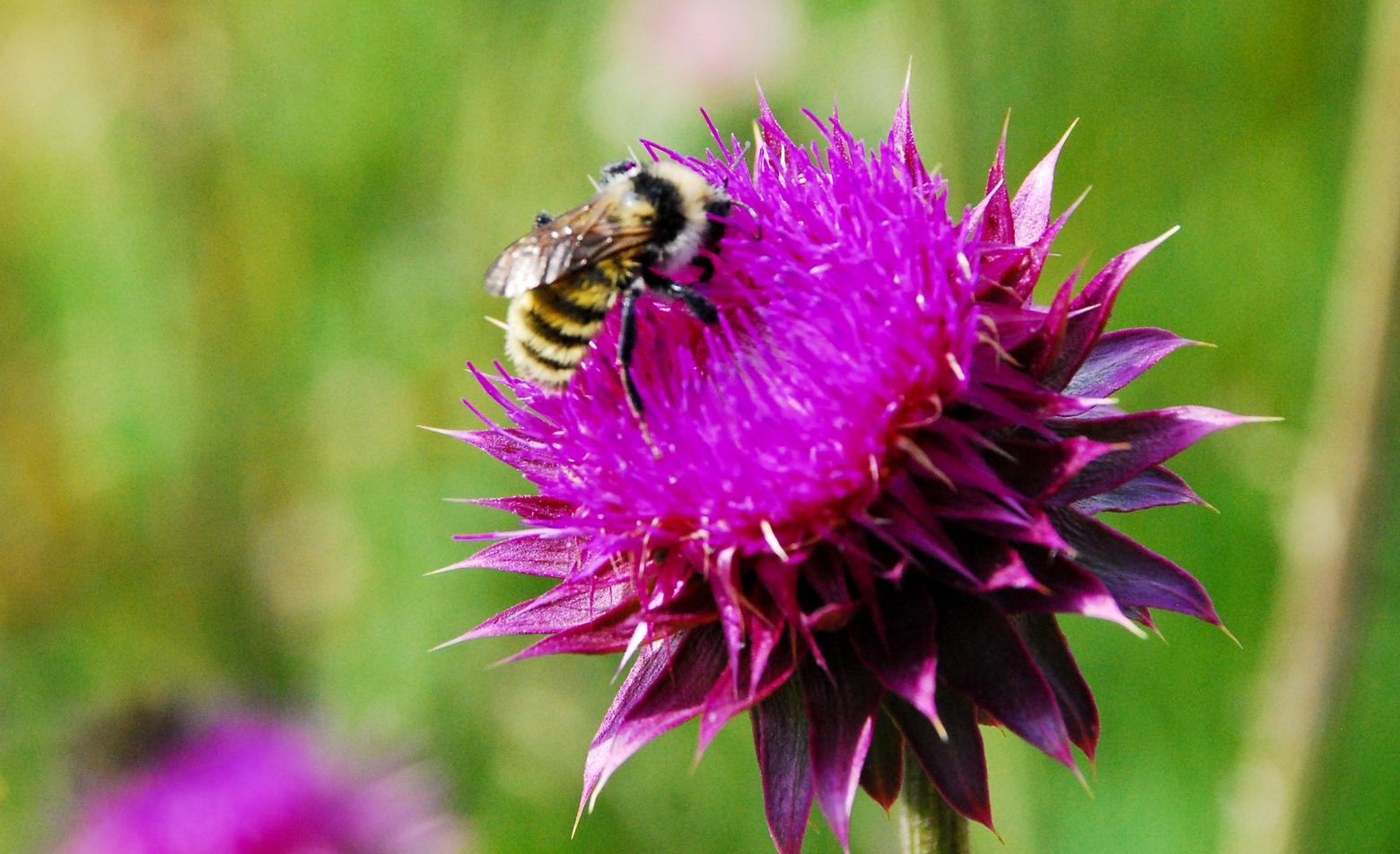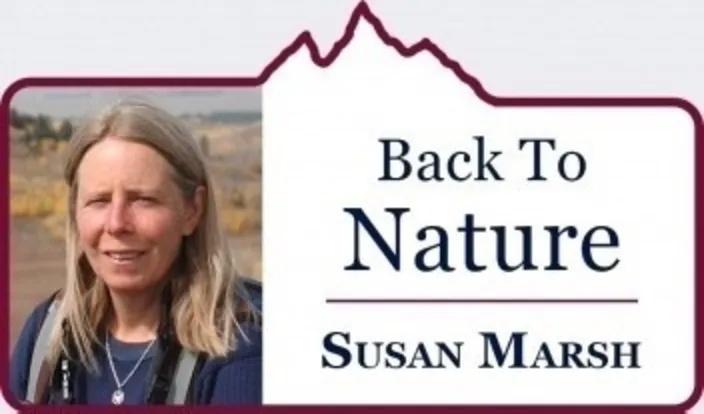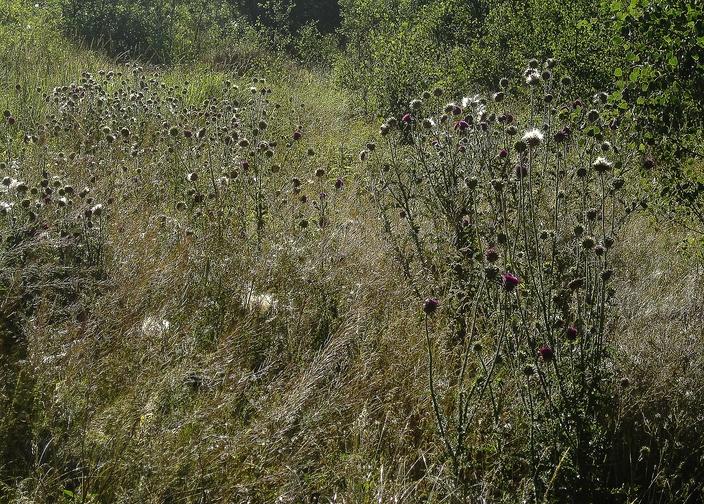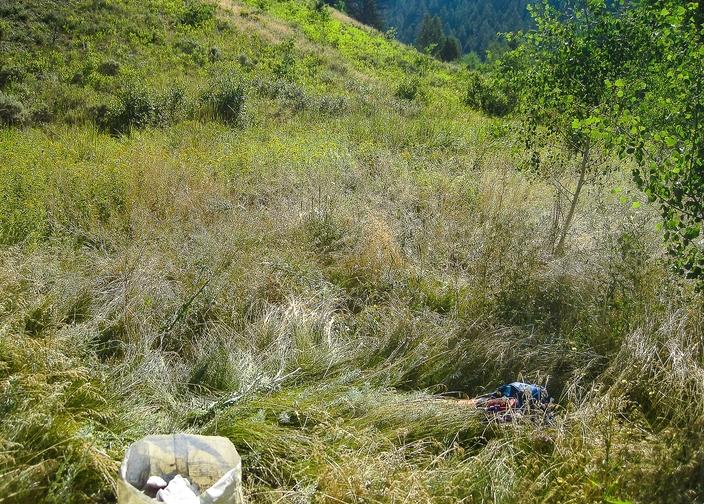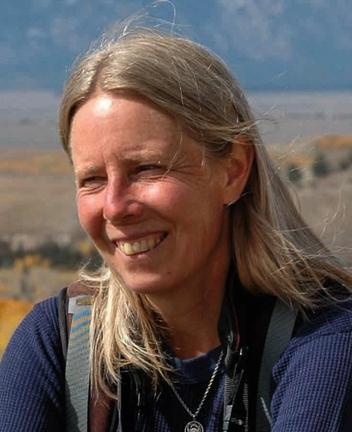Back to StoriesA Small Exercise in Hope for Greater Yellowstone
October 9, 2023
A Small Exercise in Hope for Greater YellowstoneIn trying to rid an area of invasive plants, MoJo columnist Susan Marsh explains how even small acts of conservation count
by Susan Marsh
For the past couple of years, I’ve participated in “Thistle
Thursdays” during which a group of volunteers spends the morning attempting to tamp
down the steady march of musk thistle along a popular trail near Jackson,
Wyoming.
Musk thistle is native to Eurasia, most likely introduced by
accident since its seeds have large dandelion-like parachutes allowing them to
drift on the wind and land just about anywhere, including on cargo ships. The
first recorded observation of this plant in America was in 1953. Since then, it
has thrived in nearly all of the continental U.S. and seems particularly
satisfied with conditions in Teton County.
For as long as there have been land-based plants, they have
made their way around the world in all kinds of ways—by windblown or waterborne
seed, on floating objects, and by hitching rides on migratory birds and other
creatures. So what makes musk thistle of particular concern?
Like many invasive plants, it’s a vigorous and adaptable species
and its seed production is prolific. A few plants can soon become a large
population as they successfully compete for light and nutrients with native plants,
eventually replacing them entirely. Herbicides used for weed control further
damage the few broad-leafed natives that may coexist with the musk thistle, and
treated areas often end up dominated by nonnative grasses. In short, an
invasive weed like musk thistle can have a negative impact on the biological
diversity of the places where it grows.
Unlike native thistles, whose flowers are a delicacy to elk and
horses, musk thistle is not eaten by wildlife or livestock due to its spiny
leaves and flower bracts. Because it is unpalatable, nearby meadows and
grasslands can become degraded as grazing animals avoid the thistle and forage
on other plants. This reduces their vigor and allows the musk thistle to invade
even more space.
Tackling a stand of mature, blooming musk thistle requires
care and determination. All flowers and buds are removed and placed in bags or
bins. The plant, a long-lived biennial that dies after bloom, must still be cut
below well the base or pulled if the ground is wet enough, otherwise it will
put up more flowering stems. The pulled stalk can be six feet tall and contain
enough residual energy to create more flowers, so we use clippers to cut them
into smaller pieces if necessary. Protective gear includes heavy gloves, long
sleeves and sturdy boots.
Thistle Thursdays help me feel like I’m making a tiny contribution
to the health of the environment. But that doesn’t stop me from asking myself a
more basic question: what do we mean by “weeds?”
I suspect most of us would say that a weed is a plant that
doesn’t belong where it is growing, and is not native to that place. But what
we call weeds largely depends on who we are and how we use the land. Maybe a
more accurate definition of a weed is any plant that we judge to be at odds
with our particular desires and needs.
The work is daunting, and perhaps fruitless in the long run. But isn’t all the work we do to build a better world subject to potential failure? Yet, we keep doing it ... Thistle Thursdays help me feel like I’m making a tiny contribution to the health of the environment.
If I were a more persnickety gardener, or a farmer who
depended on my crop for a living, a weed would likely be any plant, native or
otherwise, competing with my beans or wheat or spuds. Hand spinners of wool may
delight in finding a stand of nonnative and toxic-to-horses tansy, whose
mustard-yellow blooms yield a rich dye. Ranchers whose cattle graze the
national forest would prefer to see a minimum of tall larkspur, which is toxic
to cattle. But it's a native plant, and belongs here. A noxious weed to some; a
component of the beautiful, tall forb cover type to others.
Musk thistle, like most nonnative plants, isn’t 100 percent
evil. Bees, butterflies and other pollinators are attracted to its wide table
of magenta disk flowers. It blooms in mid to late summer when many of the
native wildflowers are on the wane, offering an alternative to insects. Its
seeds are eaten by songbirds, and they contain a compound believed to help with
liver function. In places where it’s native, the pith of the stalk is cooked
and eaten by people.
While musk thistle is the focus of attention during Thistle
Thursdays, it’s joined by hound’s tongue, salsify, toadflax and other nonnative
plants, which we also try to remove before they go to seed. Success, however,
is a far reach: Jackson Hole has witnessed a startling and steady increase in a
number of invasive weeds that were rare or absent 30 years ago. In August,
hillsides and river bottoms carry a pinkish blush from large swaths of
knapweed. The spread of cheatgrass is easy to spot by its straw-colored patches
on the hills around the valley.
I suspect that despite our best efforts, these nonnative
plants will work themselves into the ecosystem and become part of it, perhaps
to the detriment of native plants, wildlife and the fire-resiliency of our
community, since some of these plants mature and dry quickly or contain
flammable compounds. Given enough time, natural processes will sort them out,
but that sorting won't necessarily reflect our preferences. Rather, those
species best suited to a rapidly changing climate will likely win out over the
beloved native wildflowers that are less adaptable.
On Thistle Thursdays, people whizzing past on bikes yell
thank-you’s while some friends shake their heads sardonically. “You’re pissing
in the wind,” one tells us. But before-and-after photographs show that our
three hours of work made a difference, at least for this year and in this small
place. Perhaps our efforts will give native plants a head start next season. And
there is some satisfaction involved: at the end of a morning weed pull, the
beds of two pickup trucks are filled with bags of musk thistle blossoms and I
can almost feel the remaining native plants stretching out and breathing a sigh
of relief.
We know that we’ll be back next year in the same place. We
will have missed some rosettes that were waiting to mature and bloom, and there
is a constant seed source from upwind where thistle patches aren’t being
treated. There is no doubt that this can be discouraging work, and I ask myself
whether the time spent is worth it. We think we’re doing a good thing, using
our hands instead of poisons, allowing native plants to come in behind the
thistles instead of the nonnative grasses that dominate after musk thistle has
been sprayed.
In places where some of us have been working every week (or
day) for several years, the land looks notably weed free. Yet we never indulge
in self-congratulation. What will happen when we die off and the next
generation doesn't want to spend half a day each week cutting down musk thistle
as thick at the base as my wrist and whose leaves and flower bracts have spines
that penetrate thick gloves? Part of me admits that I am likely just pissing in
the wind, and part of me is glad I did my little bit, for however long its
effects may last.
The work is daunting, and perhaps fruitless in the long run.
But isn’t all the work we do to build a better world subject to potential
failure? Yet, we keep doing it. We want to help, if only a small amount, and if
only temporarily. The work feels like service, like the opposite of cynically
saying, “The hell with it. I’m just going to enjoy my life for as long as it
lasts.”
Pulling weeds and filling buckets with their flowers is not
so different from tending a garden at home. We’re tending a larger garden, of
course, the Eden that we inherited. Most of all, we’re expressing what is
perhaps the most fleeting and precarious of human sentiments these days: hope.
Related Stories
September 28, 2017
The Lords Of Yesterday Are Back And They Want America's Public Land
Barry Reiswig—a backcountry horseman, hunter, angler and former civil servant —pushes back against what he calls "the radical agenda" of Interior...
September 23, 2017
Grizzlies Deserve More Than Bullets
Phil Knight saw his first Yellowstone grizzly 35 years ago. After watching bear numbers climb, he says recovery should not be...
December 26, 2017
Trading Away Wildness For Oil And Tax Breaks
A respected Wyoming conservationist schools a U.S. senator after he votes to open the Arctic National Wildlife Refuge to energy development...

